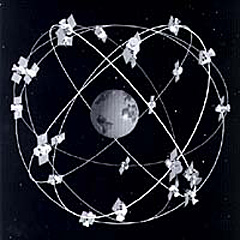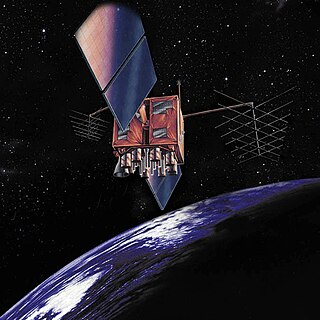Related Research Articles

The Global Positioning System (GPS), originally Navstar GPS, is a satellite-based radionavigation system owned by the United States government and operated by the United States Space Force. It is one of the global navigation satellite systems (GNSS) that provides geolocation and time information to a GPS receiver anywhere on or near the Earth where there is an unobstructed line of sight to four or more GPS satellites. It does not require the user to transmit any data, and operates independently of any telephonic or Internet reception, though these technologies can enhance the usefulness of the GPS positioning information. It provides critical positioning capabilities to military, civil, and commercial users around the world. Although the United States government created, controls and maintains the GPS system, it is freely accessible to anyone with a GPS receiver.

GLONASS is a Russian satellite navigation system operating as part of a radionavigation-satellite service. It provides an alternative to Global Positioning System (GPS) and is the second navigational system in operation with global coverage and of comparable precision.

GPS Block III consists of the first ten GPS III satellites, which will be used to keep the Navstar Global Positioning System operational. Lockheed Martin designed, developed and manufactured the GPS III Non-Flight Satellite Testbed (GNST) and all ten Block III satellites. The first satellite in the series was launched in December 2018.

GPS satellite blocks are the various production generations of the Global Positioning System (GPS) used for satellite navigation. The first satellite in the system, Navstar 1, was launched on 22 February 1978. The GPS satellite constellation is operated by the 2nd Space Operations Squadron (2SOPS) of Space Delta 8, United States Space Force.

USA-213, also known as GPS SVN-62, GPS IIF SV-1 and NAVSTAR 65, is the first satellite in the Block IIF series of Global Positioning System navigation satellites. It will be used to relay signals for the United States Air Force Navstar Global Positioning System (GPS). The satellite was launched at 03:00:00 UTC on 28 May 2010. It will be placed into plane B of the GPS constellation, and will transmit the PRN-25 signal. PRN-25 was previously broadcast by USA-79, which was retired in late 2009 after almost eighteen years of service.

GPS Block IIF, or GPS IIF is an interim class of GPS (satellite), which are used to keep the Navstar Global Positioning System operational until the GPS Block IIIA satellites become operational. They were built by Boeing, to be operated by the United States Air Force being launched by United Launch Alliance (ULA), using Evolved Expendable Launch Vehicles (EELV). They are the final component of the Block II GPS constellation to be launched. On 5 February 2016, the final satellite in the GPS Block IIF was successfully launched, completing the block.
USA-66, also known as GPS IIA-1, GPS II-10 and GPS SVN-23, was an American navigation satellite which formed part of the Global Positioning System. It was the first of nineteen Block IIA GPS satellites to be launched, and was the oldest GPS satellite still in operation until its decommissioning on 25 January 2016.
USA-83, also known as GPS IIA-5, GPS II-14 and GPS SVN-26, is an American navigation satellite which forms part of the Global Positioning System. It was the fifth of nineteen Block IIA GPS satellites to be launched.
USA-92, also known as GPS IIA-12, GPS II-21, GPS SVN-39, and NAVSTAR 39, is an American navigation satellite which forms part of the Global Positioning System. It was the twelfth of nineteen Block IIA GPS satellites to be launched.
USA-94, also known as GPS IIA-13, GPS II-22 and GPS SVN-35, was an American navigation satellite which formed part of the Global Positioning System. It was the thirteenth of nineteen Block IIA GPS satellites to be launched.
USA-96, also known as GPS IIA-14, GPS II-23 and GPS SVN-34, is an American navigation satellite which is part of the Global Positioning System. It was 14 of 19 Block IIA GPS satellites to be launched, and the last one to be retired.
USA-126, also known as GPS IIA-17, GPS II-26 and GPS SVN-40, is an American navigation satellite which forms part of the Global Positioning System. It was the seventeenth of nineteen Block IIA GPS satellites to be launched.

USA-175, also known as GPS IIR-10 and GPS SVN-47, is an American navigation satellite which forms part of the Global Positioning System. It was the tenth Block IIR GPS satellite to be launched, out of thirteen in the original configuration, and twenty one overall. It was built by Lockheed Martin, using the AS-4000 satellite bus.

USA-248, also known as GPS IIF-5, GPS SVN-64 and NAVSTAR 69, is an American navigation satellite which forms part of the Global Positioning System. It was the fifth of twelve Block IIF satellites to be launched.

USA-251, also known as GPS IIF-6, GPS SVN-67 and NAVSTAR 70, is an American navigation satellite which forms part of the Global Positioning System. It was the sixth of twelve Block IIF satellites to be launched.

USA-256, also known as GPS IIF-7, GPS SVN-68 and NAVSTAR 71, is an American navigation satellite which forms part of the Global Positioning System. It was the seventh of twelve Block IIF satellites to be launched.

USA-260, also known as GPS IIF-9, GPS SVN-71 and NAVSTAR 73, is an American Satellite navigation which forms part of the Global Positioning System. It was the ninth of twelve Block IIF satellites to be launched.

USA-262, also known as GPS IIF-10, GPS SVN-72 and NAVSTAR 74, is an American navigation satellite which forms part of the Global Positioning System. It was the tenth of twelve Block IIF satellites to be launched.

USA-266, also known as GPS IIF-12, GPS SVN-70 and NAVSTAR 76, is an American navigation satellite which forms part of the Global Positioning System. It was the twelfth of twelve Block IIF satellites to be launched.
References
- ↑ "NANU Abbreviations and Descriptions". NavCen.USCG.gov. USCG Navigation Center. Retrieved 15 February 2023.